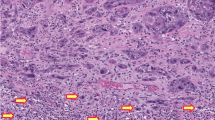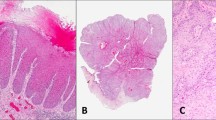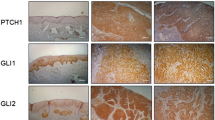Abstract
The structure and expression of 14-3-3 σ(σ) was analysed in squamous carcinomas (SCC) of the vulva and in the vulval pre-malignant lesion vulval intraepithelial neoplasia (VIN). Sequence analysis of the σ coding region did not detect mutations in any case of SCC or VIN III and loss of heterozygosity (LOH) occurred in only 2 out of 27 informative cases. In contrast to the absence of genetic change, methylation-specific PCR (MSP) analysis revealed dense CpG methylation within the σ gene in approximately 60% of cases of vulval SCC, but methylation was not detected in matched, normal epithelial tissue. Methylation was associated in all cases with reduced or absent expression of σ mRNA. There was no correlation between σ methylation and HPV or p53 status. Analysis of pre-malignant vulval intraepithelial neoplasia (VIN) revealed that σ methylation was detectable early in neoplastic development. Co-incident methylation, accompanied by loss of expression, of σ and p16INK4a was commonly detected in both SCC and VIN III, suggesting that epigenetic silencing of these two genes is an early and important event in vulval neoplasia.
This is a preview of subscription content, access via your institution
Access options
Subscribe to this journal
Receive 50 print issues and online access
$259.00 per year
only $5.18 per issue
Buy this article
- Purchase on Springer Link
- Instant access to full article PDF
Prices may be subject to local taxes which are calculated during checkout



Similar content being viewed by others
References
Basta A, Adamek K, Pitynski K . 1999 Eur. J. Gynaecol. Oncol. 20: 111–114
Brooks LA, Tidy JA, Gusterson B, Hiller L, O'Nions J, Gasco M, Marin MC, Farrell PJ, Kaelin Jr WG, Crook T . 2000 Cancer Res. 60: 6875–6877
Crum CP . 1992 Obstet. Gynecol. 79: 448–454
Dellambra E, Golisano O, Bondanza S, Siviero E, Lacal P, Molinari M, D'Atri S, De Luca M . 2000 J. Cell. Biol. 149: 1117–1129
Dhar S, Squire JA, Hande MP, Wellinger RJ, Pandita TK . 2000 Mol. Cell. Biol. 20: 7764–7772
Ferguson AT, Evron E, Umbricht CB, Pandita TK, Chan TA, Hermeking H, Marks JR, Lambers AR, Futreal PA, Stampfer MR, Sukumar S . 2000 Proc. Natl. Acad. Sci. USA 97: 6049–6054
Gonzalez-Zulueta M, Bender CM, Yang AS, Nguyen T, Beart RW, Van Tornout JM, Jones PA . 1995 Cancer Res. 55: 4531–4535
Greer CE, Peterson SL, Kiviat NB, Manos NM . 1991 Am. J. Clin. Pathol. 95: 117–124
Hawley-Nelson P, Vousden KH, Hubbert NL, Lowy DR, Schiller JT . 1987 EMBO J. 8: 3905–3910
Herman JG, Graff JR, Myohanen S, Nelkin BD, Baylin SB . 1996 Proc. Natl. Acad. Sci. USA 93: 9821–9826
Hermeking H, Lengauer C, Polyak K, He TC, Zhang L, Thiagalingam S, Kinzler KW, Vogelstein B . 1997 Mol. Cell. 1: 3–11
Iwata N, Yamamoto H, Sasaki S, Itoh F, Suzuki H, Kikuchi T, Kaneto H, Iku S, Ozeki I, Karino Y, Satoh T, Toyota J, Satoh M, Endo T, Imai K . 2000 Oncogene 19: 5298–5302
Jones RW, Rowan DM . 1994 Obstet. Gynecol. 84: 741–745
Jones RW, Rowan DM . 2000 Obstet. Gynaecol. 96: 470–472
Kagie MJ, Kenter GG, Zomerdijk-Nooijen Y, Hermans J, Schuuring E, Timmers PJ, Trimbos JB, Fleuren G-J . 1997 Gynecol. Onc. 67: 178–183
Lee YY, Wilczynski SP, Chumakov A, Chih D, Koeffler HP . 1994 Oncogene 9: 1655–1659
Leffers H, Madsen P, Rasmussen HH, Honore B, Andersen AH, Walbum E, Vandekerckhove J, Celis JE . 1993 J. Mol. Biol. 231: 982–998
Munro J, Stott FJ, Vousden KH, Peters G, Parkinson EK . 1999 Cancer Res. 59: 2516–2521
O'Nions J, Brooks LA, Sullivan A, Bell A, Dunne B, Rozycka M, Reddy A, Tidy JA, Evans DJ, Farrell PJ, Evans A, Gasco M, Gusterson B, Crook T . 2001 Br. J. Cancer 85: 1551–1556
Pinto AP, Lin M-C, Mutter GL, Sun D, Villa LL, Crum CP . 1999 Am. J. Path. 154: 1009–1015
Prasad GL, Valverius EM, McDuffie E, Cooper HL . 1992 Cell Growth Diff. 3: 507–513
Resnick RM, Cornelissen MT, Wright DK, Eichinger GH, Fox HS, ter Schegget J, Manos MM . 1990 J. Natl. Cancer Inst. 82: 1477–1484
Smits HL, Tieben LM, Tjong-A-Hung SP, Jebbink MF, Minnaar RP, Jansen CL, ter Schegget J . 1992 J. Gen. Virol. 73: 3263–3268
Suzuki H, Itoh F, Toyota M, Kikuchi T, Kakiuchi H, Imai K . 2000 Cancer Res. 60: 4353–4357
Umbricht CB, Evron E, Gabrielson E, Ferguson A, Marks J, Sukumar S . 2001 Oncogene 20: 3348–3353
Vellucci VF, Germino FJ, Reiss M . 1995 Gene 166: 213–220
Acknowledgements
Research in the laboratory of B Gusterson is supported by Breakthrough Breast Cancer.
Author information
Authors and Affiliations
Corresponding author
Rights and permissions
About this article
Cite this article
Gasco, M., Sullivan, A., Repellin, C. et al. Coincident inactivation of 14-3-3σ and p16INK4a is an early event in vulval squamous neoplasia. Oncogene 21, 1876–1881 (2002). https://doi.org/10.1038/sj.onc.1205256
Received:
Revised:
Accepted:
Published:
Issue Date:
DOI: https://doi.org/10.1038/sj.onc.1205256
Keywords
This article is cited by
-
Evaluation of 14-3-3 sigma as a potential partner of p16 in quiescence and differentiation
In Vitro Cellular & Developmental Biology - Animal (2018)
-
Estimation of groin recurrence risk in patients with squamous cell vulvar carcinoma by the assessment of marker gene expression in the lymph nodes
BMC Cancer (2012)
-
Role of 14-3-3σ in poor prognosis and in radiation and drug resistance of human pancreatic cancers
BMC Cancer (2010)
-
The 14-3-3σ gene promoter is methylated in both human melanocytes and melanoma
BMC Cancer (2009)
-
Differential tissue-specific protein markers of vaginal carcinoma
British Journal of Cancer (2009)



